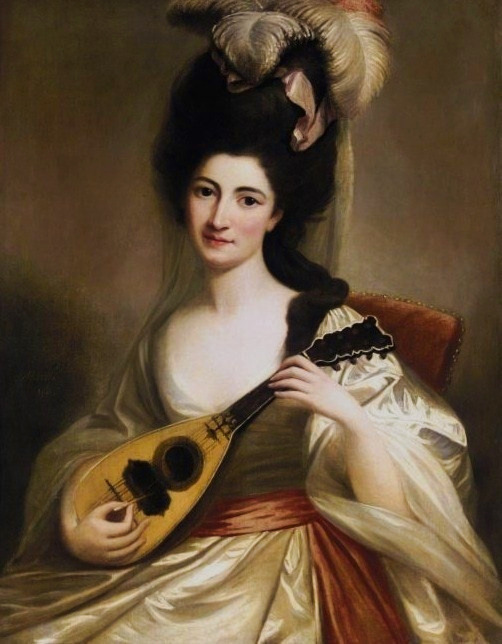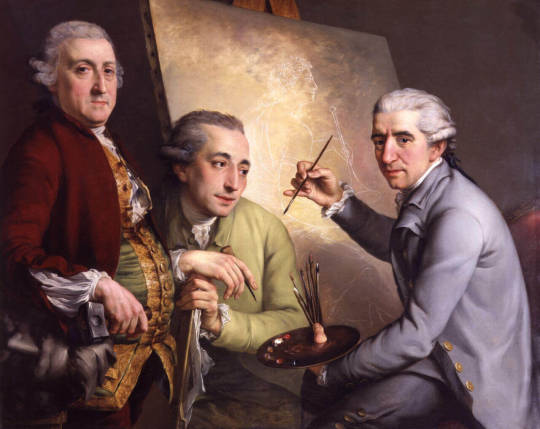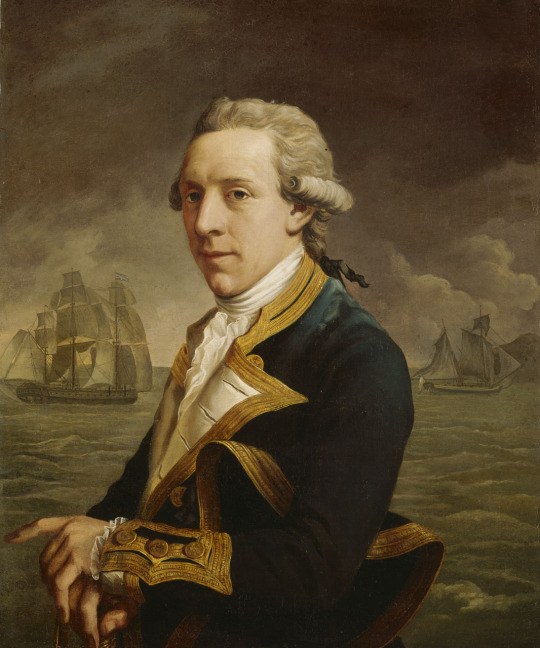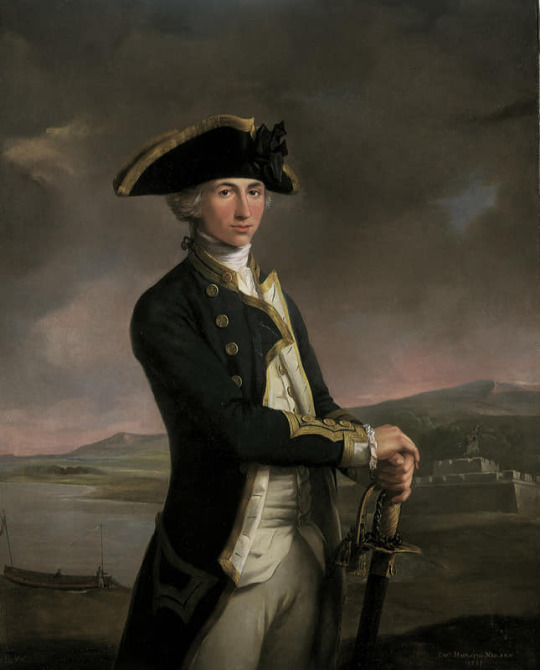#John Francis Rigaud
Photo

Détail de « Joseph Nollekens avec son buste de Laurence Sterne », par John Francis Rigaud, 1772.
Detail of "Joseph Nollekens with His Bust of Laurence Sterne", by John Francis Rigaud, 1772.
#art#painting#18th century#English art#British art#John Francis Rigaud#Academicism#1700s#1700s art#detail#classical art
425 notes
·
View notes
Photo






1780s dresses -
Top left 1782 Lady playing a mandolin by David Martin (location ?). From tumblr.com/sims4rococo76 502X644.
Top right ca. 1782 John Moultrie III and Family by John Francis Rigaud (Gibbes Museum of Art - Charleston, South Carolina, USA). From weeberry.tumblr.com/post/128775612786/history-of-fashion-ab-1782-john-francis-rigaud/amp 610X782.
Second row Lady by Adélaïde Labille-Guiard (auctioned by Sotheby's). From tumblr.com/antiquelaceartist 1280X1582.
Third row left 1783 Christine-Geneviève, Madame Mitoire, with her children Alexandre-Laurent and Charles-Benoît by Adélaïde Labille-Guiard (location ?). From tumblr.com/sims4rococo76 802X1023.
Third row right 1788 Maria Catalina de Urrutia with her son by José Campeche (Museo de Arte de Ponce - Ponce, Puerto Rico, USA). From tumblr.com/historicalfashionnerd 2048X2872.
Fourth right 1788 Elisabeth-Philippe-Marie-Hélène de France, dite Madame Elisabeth by Adélaïde Labille-Guiard (Versailles). From chateauversailles.fr-decouvrir-histoire-madame-elisabeth size 2384X2968.
#1780s fashion#Louis XVI fashion#Rococo fashion#Georgian fashion#David Martin#high coiffure#hair feathers#scoop neckline#sash#John Francis Rigaud#curly hair#bouffant coiffure#bertha#apron#Adélaïde Labille-Guiard#jeweled hat#lapels#laced bodice#Madame Mitoire#hair flowers#modesty piece#Maria Catalina de Urrutia#José Campeche#feathered hat#V neckline#lace bertha#elbow-length sleeves#V waistline#petticoat#Madame Elisabeth
16 notes
·
View notes
Text
Swords
The sword, besides its function as a weapon, was an instrument worn as an accessory and symbolic. Thus the sword stood for leadership, power, justice, dignity and honour.

Lloyd's Patriotic Fund Sword and Belt of £100 Value to Jahleel Brenton Esq., Captain of H.M.S. Spartan, Presented in 1810 (x)
The sword is regarded as an emblem of military honour and is supposed to encourage the wearer to a righteous striving for honour and virtue. It is a symbol of freedom and strength. And so, especially in the 18th century, wealthy and high-born men carried swords to signify their status as gentlemen, such status being required of an officer in the Navy.

Captain Horatio Nelson (1758-1805), by John Francis Rigaud and an american officer, possibly Charles Goodwin Ridgely (1784-1848), by Gilbert Stuart, both with their swords (x) (x)
In battle, however, officers armed themselves often with short swords or cutlasses, which were suitable for close combat in the cramped conditions on the deck of a warship.

Naval Fighting Sword, 1770-1795 (x)
What we usually see on portraits were long swords, often with decorative hilts. These swords were dress swords, intended for display rather than combat. Sometimes officers were given valuable swords in recognition of bravery or outstanding service. These were then either taken on board or left at home and sold if necessary.

Officers sword, late 18th century (x)
When a naval officer was court-martialled, his sword was taken from him and placed on a table in the courtroom to show that his rank and standing had been put on hold. If he was acquitted, he received his sword back. If he was found guilty, the point of the sword was pointed at him and the verdict pronounced. This practice was maintained in Britain until 2004.
100 notes
·
View notes
Text

Joseph Nollekens with His Bust of Laurence Sterne
John Francis Rigaud 1772
3 notes
·
View notes
Text

Detail: Joseph Nollekens with His Bust of Laurence Sterne, John Francis Rigaud, 1772
4K notes
·
View notes
Photo

Com toda licença: "[MARS] IN FURS"
Shiny, shiny, shiny boots of leather
Whiplash [boy] child in the dark
Comes in bells, your servant, don't forsake him
Strike, dear [master], and cure his heart
Downy sins of streetlight fancies
Chase the costumes [he] shall wear
Ermine furs adorn the imperious
Severin, Severin awaits you there
I am tired, I am weary
I could sleep for a thousand years
A thousand dreams that would awake me
Different colors made of tears
Kiss the boot of shiny, shiny leather
Shiny leather in the dark
Tongue of thongs, the belt that does await you
Strike, dear [master], and cure his heart
Severin, Severin, speak so slightly
Severin, down on your bended knee
Taste the whip, in love not given lightly
Taste the whip, now bleed for me
I am tired, I am weary
I could sleep for a thousand years
A thousand dreams that would awake me
Different colors made of tears
Shiny, shiny, shiny boots of leather
Whiplash [boy] child in the dark
Severin, your servant comes in bells, please don't forsake him
Strike, dear [master], and cure his heart
[Adaptado] de Lou Reed
+
Samson and Delilah [adaptado], 1784
de John Francis Rigaud
#john francis rigaud#lou reed#the velvet underground#samson#male#male aesthetic#male body#male in art#male beauty#maleinart#queer#my edit#man
4 notes
·
View notes
Photo

John Francis Rigaud (1742-1810) - Portrait of Horatio Nelson (1781)
52 notes
·
View notes
Photo

Agostino Carlini, Francesco Bartolozzi, Giovanni Battista Cipriani, 1771 | John Francis Rigaud | Wikimedia Commons (Dominio public)
1 note
·
View note
Photo

John Francis Rigaud - Romeo and Juliet.
1 note
·
View note
Photo

Captain Vincenzo Lunardi with his Assistant George Biggin, and Mrs. Letitia Anne Sage, in a Balloon
Artist: John Francis Rigaud 1785
Yale Center for British Art, Paul Mellon Collection
55 notes
·
View notes
Photo

Portrait of Horatio Nelson
John Francis Rigaud, 1781
110 notes
·
View notes
Photo

1779 John Francis Rigaud - Captain Robert Man
(National Maritime Museum, Greenwich, London)
112 notes
·
View notes
Photo

‘Samson’ (detail), c.1784 by John Francis Rigaud (1742–1810). French history, portrait, and decorative painter. oil on canvas
147 notes
·
View notes
Text
Nelson in the War of American Independence:

Captain Nelson in 1782, painted by John Francis Rigaud.
“In 1782, twenty-three-year-old Captain Nelson was commanding his third post-ship, a former French prize named Albemarle. She was a top-heavy tub; a twenty-eight-gun frigate that looked like a store-ship, and probably had been in her previous existence. Nelson patrolled the northeastern coast of the United States in her from July to September 1782, operating in Boston Bay.
He did not care for taking fishing schooners as prizes, reasoning that they were a man’s livelihood (and not worth very much in a prize court, at that). In one notable instance, in July he took a fishing boat, the Harmony from Cape Cod, intending to use her master and his crew as pilots and the ship as a tender. In August, Captain Nelson discharged his pilots and returned their ship.
Years later, as a commodore in the Mediterranean, Nelson would provide Tuscan fishermen with passports to allow them to go in and out of British blockaded harbors with their boats, perhaps remembering in particular the men of the schooner Harmony.”

"These are to certify that I took the schooner Harmony Nathaniel Carver master belonging to Plymouth, but on acct of his good services have given him up his vessel again.
Dated onbd His Majestys Ship Albemarle 17 August, 1782, in Boston Bay
Horatio Nelson"
Source: Jennifer N & The Boston Garrison.
7 notes
·
View notes